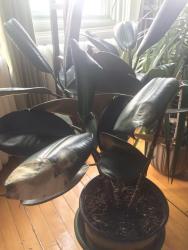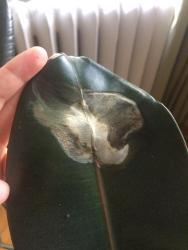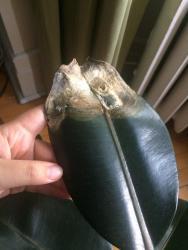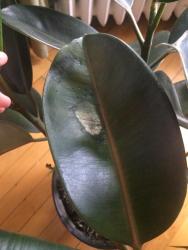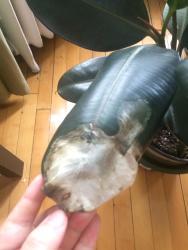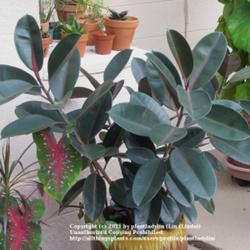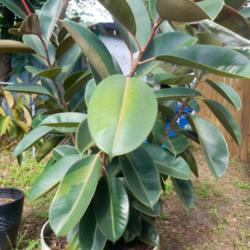If the pot was full of water, it must not have a drain hole in the bottom. If that is the case, that's a tricky growing situation because adding too much water can make plants ill, and be fatal.
It doesn't look like it will not live, but I would not call that a healthy plant or establish as a goal for another specimen to look like that one. Examples of robustly healthy Ficus elastica:
The foliage of any plant can only reflect the health of the roots, and at some point, if you want an increase in the overall above-soil mass of the plant, the roots will need room to form a bigger mass to support the increased foliage. If the root ball can slide out of the pot intact, the roots have run out of room to grow, and likely tangled into an unhealthy spiral/pancake at the bottom, AKA rootbound, potbound. No plant likes to be rootbound. What is necessary for plants to stay alive is for their roots to not rot, which can happen so easily in a pot with dense soils, like ground dirt, or bagged mixes of predominantly tiny particles of peat, (or to simply shrivel from simply never getting any water.) Having very little soil around the roots would make the soil dry more quickly, and for even the most dedicated plant-overwaterers to not rot the roots of their plants. This is not ideal, since most non-cactus plants are stressed by dry conditions, it's just a way of coping with soil that has little air in it when moist.
Negative experiences in regard to potting-up, where an undisturbed root ball is placed into a bigger pot with more soil around it, vs. doing a repotting, as described below, can give rise to old wives' tales about plants not liking to be repotted/disturbed. Potting-up a root-bound plant that has roots surrounding the outside root ball often lead to this negative experience because those roots had adapted to accessing oxygen around the outside of the root ball and surrounding them with more dense, soggy-but-airless potting soil will likely lead to suffocation.
The reason bonsai masters are able to keep potted entities alive for hundreds of years is because they care for the roots by trimming them and changing the soil. A plant grows from the roots-up, so if the roots are not healthy, gorgeous foliage will decline &/or no flowers can form. When you unpot a plant and find a pancake of roots at the bottom, chopping that off will give roots a chance to grow normally again for a while and will make removing the old soil easier.
Roots need oxygen & moisture at the same time to function. Just air = shriveling. Just moisture = suffocation & rotting. Either will cause root death and dessicated foliage because the roots have been unable to deliver moisture. Having to let soil dry, as if ones' tropical jungle plant was a cactus, is an unnecessarily stressful coping mechanism for non-desert dwelling plants in soil without enough oxygen for the roots to stay healthy when it is moist and can lead to premature loss of older leaves and in extreme cases, dry shriveled roots/dead plant.
The ability of roots to be able to function properly depends greatly on the soil structure/texture, which can change over time. Potting soil tends to be very dense, mostly peat, with very little air in it. Any kind of organic ingredients decompose into smaller bits over time, and roots fill air spaces over time as they grow through soil. Replacing soil periodically is usually necessary to keep plants healthy because of these reasons. A more porous, chunky, airy soil (like cactus/palm, if one is buying bagged,) can have more air in it even when it is moist because there is space between the particles. When there are tiny particles of any kind in a pot, such as peat, sand, silt, clay, they filter into all of the tiny spaces in a pot, eliminating the air. "Overwatering" is the label and manifestation when roots have suffocated and/or rotted, combo of both. Over time, organic bits decompose into smaller bits, so even the "best" soil, if it has organic components, will need to be replaced when this happens. The speed at which this happens depends on many variables, but on average, about 1-3 years.
